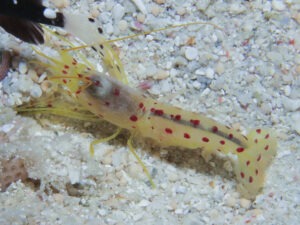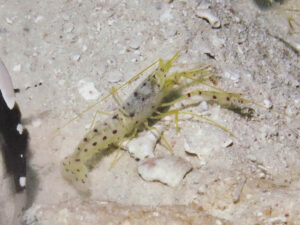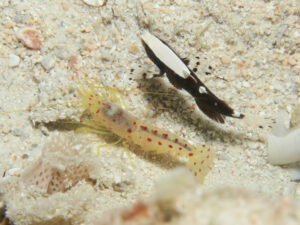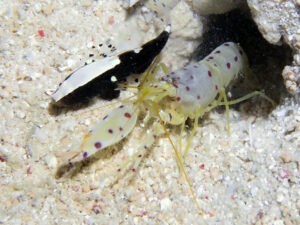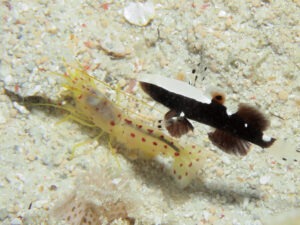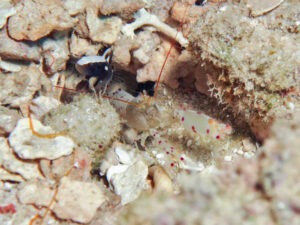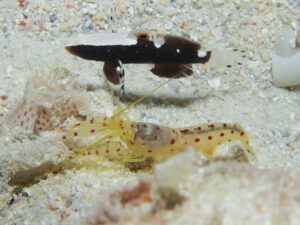Spotted Snapping Shrimp
Alpheus rubromaculatus complex
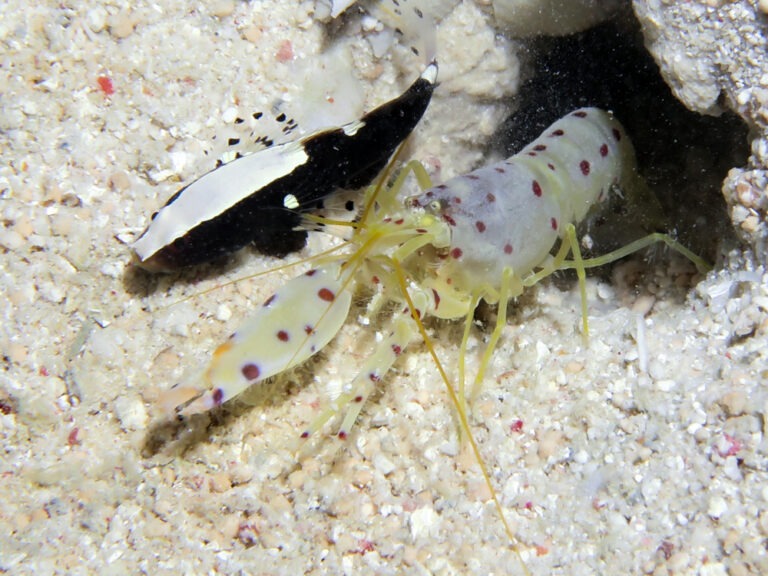
Spotted Snapping Shrimp
Alpheus rubromaculatus complex
undescribed
Description
A shrimp unlike any other, this is a slender pale yellow creature with purple-red spots decorating its carapace, abdomen, tail and nippers.
Carapace: is off-white to yellow with a row of purple spots along the top in continuity with a similar row on the body. The sides of the carapace are plain with about four well-spaced spots.
The abdomen is pale yellow with well-defined rows of spots along the top and sides. There is a faint white band on segment one. The tail is the same colour with two transverse rows of spots.
The rostrum and appendages are yellow.
The antennae are yellow or red.
The chelae or pincers are yellow with red or purple spots. They show an extreme difference in size.
The legs are yellow and unspotted.
Variant form
The Solomon Island form is white with fewer spots on the body, pink and orange spots on the nippers, spotted legs and bright red antennae.
We consider this colour form to be the same species because illustrations in the literature seem to show intermediate gradations of colours.
Similar Shrimps
The Spotted Shrimps are distinctive and unlikely to be confused with other partner shrimps. Their association with gobies of the genus Lotilia further sets them apart.
Nomenclature
The scientific name Alpheus rubromaculatus, Karplus, Szlep and Tsurnamal, 1981 has been applied to this shrimp. It is apparently invalid as the species has not been properly described, Debelius (2001).
Hayashi & Shiratori (2003) Alpheus species 2 from Japan.
Anker (2010) considers that the name Alpheus “rubromaculatus” covers 2 sibling species.
It must be remembered that there is also a geographically isolated population of this shrimp in the Red Sea which is associated with a closely related but different goby species, Lotilia graciliosa.
Alternative common name
Purple-spotted Shrimp
Taxonomy
Debelius (2001) Crustacea p153 has images of a similar-looking shrimp and gives the name Alpheus rubromaculatus, with the common name Red Spot Snapping Shrimp. Length 3. 5 to 4 cm. Distribution Red Sea, Malaysia and Indonesia, probably the entire Indo-West Pacific. He also states that the name is invalid because the species has not been properly described.
Humann & DeLoach (2010) p85 has images of a similar-looking shrimp and gives the name Alpheus species 1, common name Undescribed. Size to 7 cm. Indo-West Pacific.
Anker (2001) considers the name Alpheus rubromaculatus to include two sibling species.
The yellow form we have only recorded in Australia, on the Great Barrier Reef. The white form with pink and orange spots we have found in the Solomon Islands.
Ecology
HABITAT
Preferred substrate A mixture of pebble-like coral fragments normally found on the ledges in medium-profile fringing reefs and the moderately coarse non-cohesive sand that runs down the slope from above.
Depth range 5 to 25 metres
Proximity to reef On slopes of fringing reefs, often under overhangs or large coral bommies.
NATURAL HISTORY
We have only seen this shrimp in association with one shrimpgoby, Lotilia klausewitzi, the Whitecap Shrimpgoby of the Western Pacific. It (or a similar species) is also associated with Lotilia graciliosa, the Graceful Shrimpgoby of the Red Sea. This is a very specific relationship.
The Spotted Snapping Shrimp is typically found with Lotilia klausewitzi, Whitecap Shrimpgoby on the sand and rubble caught on ledges on the wall of fringing reefs. Coral fragments feature large burrow construction.
The shrimp is always considerably larger than the shrimpgoby, often several times its size.
Behaviour
This shrimp’s behaviour is dictated by the fact that the partner goby is often much smaller than the shrimp. The goby usually remains hovering above the shrimp the entire time. Often remaining between the antennae.
Managing the juvenile goby
Lotilia klausewitzi is a tiny goby even fully grown. When it is very small a large Spotted shrimp will keep it close, keeping the fish hovering above its back and supported by an antenna on either side as it moves around foraging or constructing the burrow entrance.
Alternatively, it may simply push its partner goby around on top of a load of sand, as do other shrimps when teamed up with a juvenile or inexperienced goby.
The burrow
The burrow is usually located hard up against the rocky base of a terrace on the fringing reef. This unusual location is not unique to the Spotted Shrimp and Lotilia klausewitzi. Other shrimps, for example, the Yellow Pyjama and Sandy Snapping Shrimps construct burrows nearby.
Sealing the burrow
When the shrimp and goby retire into the burrow, which may happen at any time of the day, the shrimp seals up the entrance with small coral rocks.
The shrimp has a memory of the layout of the terrain outside the burrow. We tested this with a Spotted Shrimp by wafting away the sand outside the burrow and exposing the coral debris while the pair were sealed inside their burrow. When they emerged the shrimp immediately went on a tour of inspection and familiarisation accompanied by the shrimp. This fascinating behaviour is on video at the end of this species account.
The sand constantly trickles down from the top of the fringing reef which is why we were able to modify the surroundings so easily.
Distribution
Published distribution
Malaysia, Indonesia. Probably the entire Indo-West Pacific. Debelius (2001).
Indo-West Pacific, Humann and DeLoach (2010).
Indonesia, Malaysia, widespread Indo-Pacific and Red Sea, Kuiter and Debelius (2009).
Our records:
Australia; Flynn Reef, Ribbon Reef 3, St Crispin Reef in the northern Great Barrier Reef.
Solomon Islands; Kolombangara Island, New Georgia Islands, Nggela Islands.
Associated Goby species
Associated Shrimpgoby (one species)
Lotilia klausewitzi, Whitecap Shrimpgoby
This appears to be a very specific association and we have not seen this shrimp with any other goby, or this goby with any other shrimp.
Other Records
Kuiter and Debelius, (2009) have an image of this shrimp with an unidentified shrimpgoby that looks like Cryptocentrus maudae. This shrimpgoby is usually associated with the Pale marbled Shrimp.

